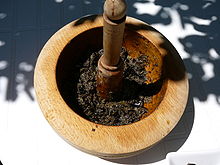Tapenade
 | |
| Type | Spread |
|---|---|
| Course | Hors d'œuvre |
| Place of origin | France |
| Region or state | Provence |
| Main ingredients | Olives, capers, anchovies |
Tapenade (French pronunciation: [tapəˈnad]; Occitan: tapenada [tapeˈnadɔ]) is a Provençal[1] name for a spread, condiment and culinary ingredient consisting of puréed or finely chopped olives, capers, and anchovies.[2] Its name comes from the Provençal word for capers, tapenas (pronounced [taˈpenɔs]). It is a popular food in the south of France, where it is generally eaten as an hors d'œuvre spread on bread, and sometimes used to stuff poultry for a main course.
History of similar dishes[]

Olive-based dishes with anchovies or vinegar are ubiquitous in Italian cuisine, documented in ancient Roman cookbooks dating back more than a thousand years before the appearance of the Occitan word tapenade. One of the earliest known of such Italian recipes, Olivarum conditurae, appears in Columella's De re Rustica written in the first century AD.[3][4] Cato the Elder (234–149 B.C.) also includes a recipe for epityrum, an olive spread very much like a tapenade, in chapter 119 of his On Agriculture. The use of capers is the hallmark of recipes for tapenade.[citation needed]
Sometimes tapenade is confused with New Orleans olive salad, a critical component in the New Orleans sandwich the muffaletta. New Orleans olive salad is more properly called a giardiniera. It also does not contain capers, but does contain cauliflower, carrots, and celery.[citation needed]
Preparation[]
The base ingredients of tapenade are olives and capers. The olives (most commonly black olive) and capers are chopped finely, crushed, or blended. Then olive oil is added gradually until the mixture becomes a paste. In various regions tapenade is often flavoured differently, with other ingredients such as garlic, herbs, anchovies, lemon juice, or brandy.[citation needed]
Serving[]
Tapenade may be used as part of an appetizer served as a topping on crusty bread or crudités. It may also be used as a condiment and in preparing fish dishes.[citation needed]
See also[]
| Wikimedia Commons has media related to Tapenade. |
- Relish
- List of spreads
- Mediterranean cuisine
References[]
- ^ Wright, Clifford A. "What is Tapenade?". What is Tapenade?. Clifford A Wright. Retrieved 4 July 2011.
- ^ Food, BBC. "Tapenade". BBC Food. British Broadcasting Corporation. Retrieved 4 July 2011.
- ^ "Olivarum Conditurae (from Columella's de re Rustica)". Retrieved 2013-01-20.
- ^ "De Re Rustica of Columella". Loeb Classical Library edition. 1941. Retrieved 2013-01-20.
- Cuisine of Provence
- Occitan cuisine
- Spreads (food)
- Anchovy dishes
- Olive dishes